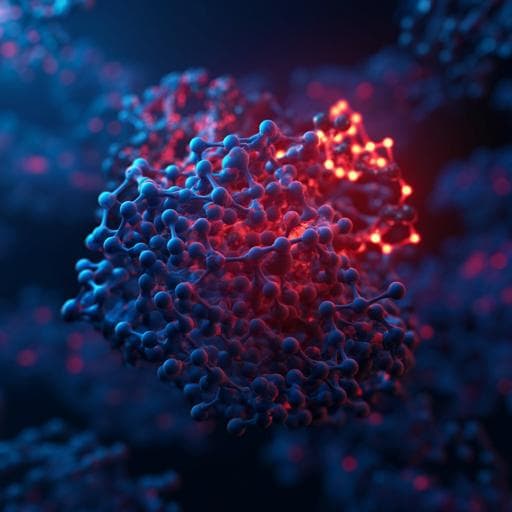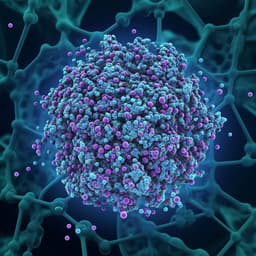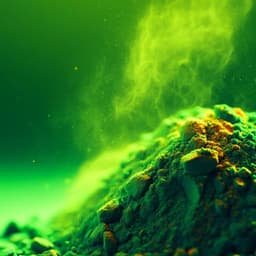
Chemistry
Visible light-induced switching of soft matter materials properties based on thioindigo photoswitches
S. L. Walden, P. H. D. Nguyen, et al.
Discover the innovative approach by Sarah L. Walden and team to enhance the solubility of thioindigos in polymers, paving the way for their application in soft matter materials. This breakthrough enables light-responsive materials that can adjust their properties and stiffness, providing exciting opportunities in biological research.
~3 min • Beginner • English
Introduction
The study addresses the challenge of deploying thioindigo photoswitches in soft matter due to their poor solubility and strong aggregation in conventional solvents and polymers. While azobenzenes and other common photoswitches are widely used, their cis conformers often exhibit a broad geometry distribution due to low rotational barriers about the C–N bond, limiting spatial control. In contrast, (thio)indigos undergo a defined 180° rotation around the central C=C bond with a blue-shifted cis absorption, providing superior spatial control. However, applications in polymeric and aqueous environments remain limited by solubility and aggregation. The purpose of this study is to synthesize a polymerizable thioindigo bismethacrylate, incorporate thioindigo units covalently into polymer backbones and crosslinked hydrogels, map optimal visible-light wavelengths for reversible trans/cis switching via a photochemical action plot, and demonstrate visible-light modulation of hydrogel optical/mechanical properties, including in water, with biocompatibility.
Literature Review
Common photoswitches include azobenzenes, diarylethenes, spiropyrans, and bisimines; azobenzenes are prevalent in biosciences but limited by broad cis-geometry distributions from C–N rotation. Similar limitations occur in fulgimides and stilbenes. Indigoid and thioindigo derivatives afford precise spatial control via 180° C=C rotation, with cis absorption blue-shifted due to nonbonding S/N–O interactions rather than steric planarity loss. Historically, thioindigo applications in soft materials are scarce: dye-doping of ferroelectric liquid crystals and solid supports, molecular tweezers at micromolar concentrations, and recent use as dopants in polymer thin films. A key barrier is extremely low solubility in most organic solvents and polymers, causing aggregation, reduced reactivity, broadened spectra, and difficulties in NMR isomer identification. Side-chain modifications (alkyl, siloxane) alleviate aggregation but remain limited to dopant roles. Sulfonated thioindigo derivatives achieve water solubility only at 1–5 μM before aggregation dominates. Thus, strategies that enhance solubility/compatibility and enable covalent incorporation into polymers and hydrogels are needed.
Methodology
- Synthesis of polymerizable photoswitch: Prepared thioindigo bismethacrylate (trans-1) on gram scale (overall yield 15.4%) without column chromatography. Characterized by UV–Vis and NMR. Solubility screening identified chloroform as suitable up to 5 mM.
- Photophysics and action plot: Recorded UV–Vis spectra showing trans peak at 540 nm and cis peak near 490 nm with isosbestic point at 503 nm. Conducted reversible green (540 nm) and blue (490 nm) cycling for >10 cycles in CHCl3. Determined wavelength-dependent quantum yields and photostationary isomer ratios using a tunable OPO laser (nanosecond pulses) with in situ absorbance monitoring; normalized switching rates by photon flux to construct a photochemical action plot. Measured thermal relaxation half-life at 24 °C in CHCl3.
- Polymer synthesis (linear PEG): Prepared PEG44-(SH)2 and performed free-radical thiol-ene step-growth polymerization with trans-1 using AIBN at 65 °C in CHCl3 to afford thioindigo-containing polymer P1 (Mn ≈ 13,058 g mol−1, Đ = 2.73). Assessed photoswitching by UV–Vis in solvents spanning dielectric constants (dioxane, CHCl3, THF, MeOH, DMF, DMSO, water); used LEDs centered at 540 and 470 nm based on action plot.
- Thermoresponsive physical gel of P1 in water: Prepared aqueous P1 solutions (≥5 wt%) forming gels at 37 °C. Performed rheology (plate–plate, 12 mm, 0.2 mm gap) with light delivered via a liquid light guide, tracking storage modulus G′ under alternating 540 nm and 470 nm irradiation and during dark recovery over multiple cycles.
- Quantum chemical calculations: Employed Gaussian 16 with M06-2X/def2-SVP and SMD (dichloromethane) to optimize trans/cis geometries, compute HOMO–LUMO gaps, relative Gibbs free energies, dipole moments, and absorption wavelengths. Scanned potential energy surfaces along dihedral rotation in S0 and S1; characterized S1 states (π–π* for trans, n–π* for cis). Modeled hydrogen-bonded thioindigo–MeOH complexes in S1 to quantify H-bond energies and infer solvent effects on rotational barriers.
- Crosslinked hydrogel fabrication: Generated precursor P2 by thiol-ene reaction of trans-1 with PEG12-(SH)2 (AIBN, CHCl3, 65 °C), yielding a DMF-soluble crosslinker. Crosslinked via catalyst-free nucleophilic thiol–propiolate click with PEG448-(propiolate)4 in DMF to form organogels, then water-swollen to hydrogels. Varied thioindigo content (GelT0–GelT5, 0–5.5 wt%) and measured equilibrium swelling ratios and mechanical properties; monitored UV–Vis changes upon green/blue irradiation.
- Biocompatibility assays: Exposed HEK-293T cells and human PBMCs to hydrogels (including irradiated vs non-irradiated) for 24 h. Assessed apoptosis/viability by Annexin V and propidium iodide staining with flow cytometry; documented morphology via microscopy. DMSO served as positive cytotoxic control. Statistical analyses used one-way ANOVA with Tukey post-hoc (n=3).
Key Findings
- Action plot and photophysics: Largest quantum yields at 530 nm: Φ(trans→cis) = 0.18±0.02; Φ(cis→trans) = 0.62±0.05. Optimal irradiation windows: 540–550 nm (maximize cis enrichment) and 450–470 nm (maximize trans enrichment). Maximum cis/trans ratio at PSS ≈ 72.5% around 550 nm; maximum trans/cis ratio 94.5% at 400 nm. Minimal trans→cis in 350–400 nm. Thermal cis→trans half-life ≈ 24 min at 24 °C in CHCl3. Reversible switching over >10 cycles without significant photodegradation.
- Polymer P1 photoswitching: P1 displays similar absorption features to trans-1 and reversible switching under 540 nm and 470 nm LEDs across solvents. Nonpolar aprotic solvents: cis/trans absorbance ratio at PSS decreases with increasing dielectric constant (dioxane ε=2.25: 0.57; CHCl3 ε=4.72/7.58: 0.43). In highly polar/protic solvents (MeOH, water), spectra broaden due to aggregation, but 540 nm peak decreases under green light and recovers under blue, with stable cycling up to 10 times.
- Thermoresponsive P1 hydrogel (physical gel): At 5 wt% in water and 37 °C, forms a gel with G′ ≈ 1000 Pa. Green light (540 nm) reduces G′ to ≈100 Pa; blue light (470 nm) restores to ≈60% of initial. Multiple reversible cycles; spontaneous dark recovery at 37 °C to near blue-irradiated level.
- Computations: Trans isomer more stable than cis by ~0.396 eV; computed λabs: trans 472 nm, cis 444 nm; dipole moments: trans 4.39 D, cis 5.87 D. Excited-state rotation barriers: trans→cis 0.423 eV; cis→trans 0.37 eV. Hydrogen bonding with MeOH in S1 contributes ~0.4 eV per H-bond (~0.8 eV for two), increasing rotational resistance and suppressing photoswitching in protic solvents; polar environments favor trans at PSS.
- Crosslinked hydrogels (GelT0–GelT5): Thioindigo incorporation visibly colors gels (≥0.55 wt% red; ≥1.6 wt% opaque deep red). Equilibrium swelling ratio decreases as thioindigo content increases (GelT0: 91.3%±0.4 to GelT5: 81.4%±1.5), with increased stiffness at full swelling, indicating aggregation-enhanced network reinforcement. GelT5 UV–Vis shows reversible 540 nm decrease under green and recovery under blue.
- Light- and thermo-modulable stiffness in GelT5: At 24→37 °C, G′ increases from ~4.1 to ~4.7 kPa. Green light at 37 °C decreases G′ to ~3 kPa; blue light recovers to ~3.8 kPa. Reversible for up to 10 cycles; green light also increases swelling ratio from 81.4% to 85.2% (network softening/expansion). Gels GelT3 and GelT4 show smaller stiffness switching (≈3% and 8% G′ variation), whereas GelT0–GelT2 show no light-induced changes.
- Biocompatibility: HEK-293T cells maintain morphology with hydrogels pre/post 540 nm irradiation; viability >90% after 24 h. PBMCs viability >80% with hydrogels; DMSO positive control shows >90% late apoptotic/necrotic cells. Softened (green-irradiated) gels promote more spread cell morphology compared to stiffer non-irradiated gels.
Discussion
The work resolves a long-standing barrier to employing thioindigo photoswitches in polymeric soft matter by enabling covalent incorporation via a bismethacrylate linker and thiol-ene chemistry. The photochemical action plot provides precise, experimentally validated irradiation windows in the visible range for efficient isomer enrichment, overcoming reliance on absorption spectra alone. Incorporation into PEG polymers retains reversible photoisomerization in diverse solvents, including water, but with solvent-dependent efficiencies; protic and polar environments reduce cis content at PSS and broaden spectra due to aggregation, consistent with computed hydrogen-bonding and polarity effects that stabilize trans and hinder rotational switching. Embedding thioindigo in crosslinked hydrogels enables reversible optical and mechanical modulation under green/blue light at physiologically relevant temperatures, demonstrating decreases in stiffness with green light and partial recovery with blue light, alongside reversible swelling changes tied to the higher dipole moment of the cis isomer. The materials and switching process are biocompatible for human cells, suggesting utility in mechanobiology where precise spatiotemporal control of stiffness is valuable. Compared to azobenzene systems, thioindigo offers robust spatial control through defined 180° rotation, albeit with slower switching kinetics and partial mechanical recovery due to aggregation of isomers within networks.
Conclusion
This study introduces a gram-scale accessible thioindigo bismethacrylate that enables covalent insertion of thioindigo into polymer backbones and crosslinked PEG hydrogels via radical thiol-ene and thiol–propiolate click chemistry. A comprehensive photochemical action plot establishes optimal visible-light windows (540–550 nm for trans→cis; 450–470 nm for cis→trans), while polymers and hydrogels exhibit reversible switching of optical and mechanical properties in organic solvents and water. Crosslinked hydrogels show light-tunable stiffness and swelling at physiological temperature, and the materials and switching are biocompatible with HEK-293T cells and PBMCs. These findings position thioindigo photoswitches as viable tools for soft matter and bio-related applications, including platforms to study mechanotransduction and disease models requiring spatiotemporal stiffness control. Future work could focus on enhancing switching efficiency and kinetics in polar/protic environments, mitigating aggregation to improve recovery, expanding to other polymer matrices and architectures, and implementing spatially patterned actuation in 3D cell culture systems.
Limitations
- Solvent and polarity effects reduce photoswitching efficiency in protic/highly polar media due to hydrogen bonding and stabilization of the trans isomer; cis content at PSS is diminished and spectra broaden by aggregation.
- Thermal relaxation of cis to trans is relatively fast (t1/2 ≈ 24 min at 24 °C in CHCl3), complicating characterization (e.g., difficulty obtaining pure cis NMR; observed precipitation during irradiation due to aggregation).
- In crosslinked hydrogels, switching kinetics are slower than azobenzene-containing systems, attributed to hydrogen-bonding constraints and limited free volume; mechanical properties do not fully recover to pre-irradiation values, likely due to aggregation and stabilization of cis conformers.
- Not all hydrogel formulations exhibited light-responsive stiffness changes (no effect for low thioindigo content GelT0–GelT2; modest effects for GelT3–GelT4), indicating dependence on chromophore loading and microstructure.
- Initial methacrylate polymerization routes (free-radical and base-catalyzed Michael additions) failed, indicating limited reaction scope and necessitating specific radical thiol-ene conditions.
Related Publications
Explore these studies to deepen your understanding of the subject.







